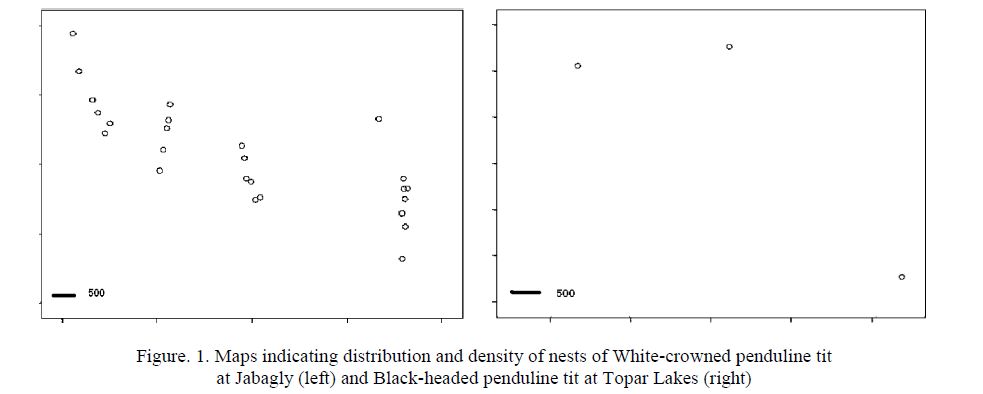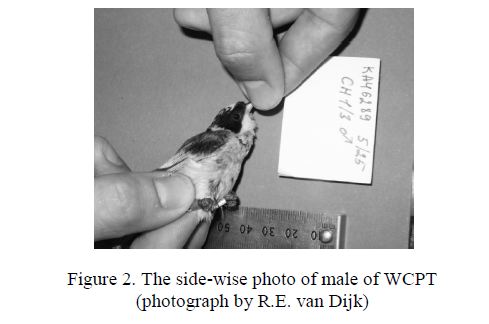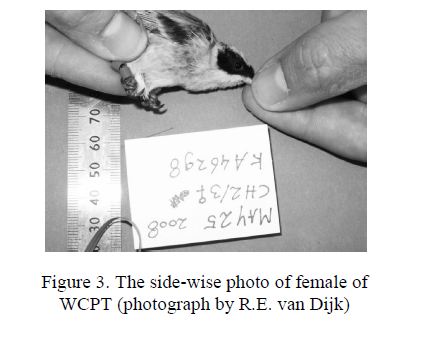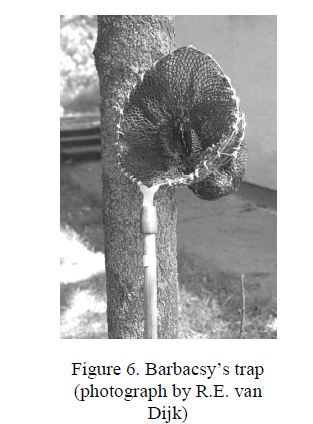For investigation hard to studied species of birds it is requires to use new more accurate research methods. In a frame work of the project “Investigation ecology of Penduline tits” were used and evaluated innovative research methods and this article is concerned to them elucidated. All of following research methods were evaluated on two species of Penduline tits in Kazakhstan: White-crowned Penduline Tit (WCPT) Remiz coronatus and Black-headed Penduline Tit (BHPT) Remiz macronyx. On the basis of the research carried out we had have new data analysed of two Kazakhsatan’s species of Penduline Tits. As has been said that the researches were carried out in a frame of the project “Investigation ecology of Penduline tits” witch has received funding from the European Community’s Sixth Framework Programme.
All following research methods were practised to describe the breeding system of White-crowned penduline tits Remiz coronatus and Black-headed penduline tits Remiz macronyx [1].
Investigation of White-crowned Penduline Tit (WCPT) was conducted in the foothills of the western Tien Shan mountain range in South Kazakhstan province in May 2008 and in June 2008. The habitat of the White-crowned penduline tit consisted of hawthorn (Crataegus sp.) trees with a few willows (Salix sp.) and poplars (Populus sp.) aligning small streams coming down from the Tien Shan mountains through the foothills. The penduline tits build their nests in these trees, and use various, yet typical, materials for their nests — material which appears to be scarcely available. In the area were founded total 32 nest (Fig. 1).
Black-headed Penduline Tit (BHPT) is a poorly known species only occurring in Central Asia. We studied Penduline Tit in the Topar Lakes along the Ili river delta near Lake Balkhash, Almaty province in June 2008. The habitat of Topar lake is consisted of semidesert interspersed with small lakes and marshes. The relatively small lakes in these sand dunes apparently contained too little vegetation for penduline tits. It also seemed rather dry containing very little food. Food resources in these reed beds were plentiful. Nest material too was much more abundant then at Jabagly mainly due to the abundance of reed and bulrush.

Figure. 1. Maps indicating distribution and density of nests of White-crowned penduline tit at Jabagly (left) and Black-headed penduline tit at Topar Lakes (right)
Objectives
- To describe sexual dimorphism;
- Biometrics and song recording;
- Investigation of nest building and incubation
Sexual Demorphism
White-crowned penduline tits have a sexually dimorphic plumage, the extent to which has yet to be analysed: Males generally have a wider mask than females which may extend onto the nape, sometimes only leaving a white crown. Males are also more brightly coloured with darker mantle and wing coverts, and whiter crown than females. Females may have black on the nape too [2].
Data collection
To investigate sexual demorphism more accurately we have used an information technology. We did 12 photos of each bird from front and side-wise sides (Fig. 2 and Fig. 3). For making this photos we used following equipments: digital camera, gray card, ruler, yellow notes, waterproof pen [3].
Data analyses
All received photos were processed by PhotoShop Programme and mains morphologic characteristics were represented as numerically.

Figure 2. The side-wise photo of male of WCPT (photograph by R.E. van Dijk)

Figure 3. The side-wise photo of female of WCPT (photograph by R.E. van Dijk)
Results
On the basis of the work carried out we had have 288 photos of 32 birds (17 mails and 15 femails). Received figures demonstrate that sexual demorphism of White-crowned Penduline Tit is not clearly defined (Fig. 4).

Figure 4. On the grafics are presented mains morphologic comparative characteristics (on the left it is width of mask; on the right it is colouring of mantle)
Biometrics and song recording
Data collection
White-crowned penduline tits are smaller and lighter than Black-headed penduline tits [4]. Equipment needed: digital calliper, ruler, Pesola spring balance.
Penduline Tits use different syllables in their song [4]. We were clearly more successful in mistnetting the birds using a playback of White-crowned penduline tit song than with a playback of the song of Eurasian penduline tits. For song recording we used high-frequency sound-recording equipment.
Results
We collected physiological measurement from 15 females and 23 males.
WCPT: mean ± SD: 7.36 ± 0.48 g, versus 9.62 ± 0.87 g, females (7.72 ± 0.52 g) seem slightly heavier than males (7.14 ± 0.27 g), as usual.
BHPT: mean ± SD: 10.75 ± 0.64 g, versus 9.62 ± 0.87 g, females (11.20 g) seem slightly heavier than males (10.30 g), as usual.
We collected sonograms from two species of Penduline Tits: White-crowned Penduline Tit and Blackheaded Penduline Tit. (Fig. 5). Received data demonstrates clearly different syllables are used, at a slightly different frequency.

Figure 5. Sonograms of typical calls of WCPT (left) and recorded at the Topar Lakes, June 2008.
Note the difference in length
Parental care
Nests are built by male and female together from stage A onwards, although an unmated male will start on its own. Sometimes the pair seems to work closely together, mostly in earlier stages of nest building, but in general they appear to work pretty much ‘independently’ of one another
Data collection
Default protocol field methods for penduline tit research, including monitoring of incubation behaviour, were used. We visited nest-building males nearly every other day and watched them for at least 15 minutes and checked whethernthe male was mated and, for mated pairs, which of them attended the nest. Fifteen minutes were sufficient to record the presence of parents.
We investigated nest attendance by male and female of White-crowned Penduline Tit and Black-headed Penduline Tit using video recordings during daylight hours during the period during pair formation, nst building, incubation and feeding. Using a timelapse video camera (Sony DCR-HC44E), set up at approximately 10m from the nest using up to 12x optical zoom, we stored one picture every five seconds.
The following time parameters were recorded per individual:
- time in (bird went inside);
- time out (bird went outside);
- time arrive at nest (bird stayed hanging on nest before going in);
- time leave nest (bird stayed hanging on nest before flying away).
To distinguish male and female parents from intruders we used colour rings, individual differences in plumage and behaviour (e.g. the presence/absence bouts of females are longer than for males; intruders are often on the outside of the nest and build very little) [5]. At 39.3 % of all frames recorded we were able to read the colour ring combination. In addition, when the birds are inside the nest the head is frequently visible.
Data analyses
We calculated, for males and females separately, the percentage of time a parent was present at the nest as well as the number of nest visits per hour. A total sample of 232816 frames was analysed frame by frame using MATLAB v. 6.5, coding presence on or inside the nest as: male-only, female-only, simultaneous nest attendance by male and female, or both parents absent.
Results
For white-crowned Penduline Tit of the 18 nests where we observed parental care, incubation was always carried out by male and female. System of parental care is biparental, with some uniparental feeding. For Black-headed Penduline Tit at the one nest where we have been able to observe incubation, this was female-only care. The male deserted when there were three eggs in the nest.
Trapping Birds
In research were used and analyzed two different trapping methods. Trapping was realized by a Barbacsy’s trap (Fig. 6) and by a mist nest. Barbacsy’s trap is used after the eighth day of incubation, to avoid unnecessary abandonment.
The Barbacsy trap is not better methods to trap Penduline tits, because there is high risk of abandonment, but it is more successful method. Less successful method, but more untroubled method it is trapping by mist nest. Equipment needed: set of poles, mist net, ropes, pins to fix ropes, portable CD-player, two speakers, dummy Penduline Tit, old nest, cotton-wool, bird bags. A mist nest is fixed in a shadow, not far from the nest. A portable CD-player is placed on the opposite of the nest and playing Penduline tit song. Cotton-wool and a dummy are used as additional baiting.
Blood sampling
We taked small (±25 μl, 1–2 cm in a capillary) sample from the brachial vein. Store blood in labelled Eppendorff tube containing Queen’s lysis buffer and refrigerate. We have collected a sufficient amount of blood samples to be able to reconstruct a phylogenetic tree of penduline tits.
Summary of collected data

Figure 6. Barbacsy’s trap (photograph by R.E. van Dijk)
Process video 8 pairs Sampled nestlings 31;
Song recording 13 males.
Conclusion
Penduline Tits are hard to study species of birds and some of them are still poorly known species, specifically taxonomy of these species. Using of innovative research methods gives opportunities to have more accurate data of morphology, physiological data and system breeding of Penduline Tits.
- Although we have limited data on the Black-headed penduline tits, we can fairly confidentially describe the breeding system of both species: The White-crowned penduline tits exhibits biparental care (NB feeding may be uniparental in some cases), whereas the Black-headed penduline tit seems to exhibit uniparental care, i.e. two radically different breeding systems within
- From observations in the field we note that both species exhibit sexual dimorphism, although much stronger in the polygamous Black-headed penduline tit. How the plumage dimorphism, song complexity, and behaviour fit the predictions in relation to conflict and cooperation remains to be analysed. We have collected a substantial amount of data to further investigate
References
- Wassink A., Oreel G.J. The Birds of Kazakhstan. — De Cockdorp, Texel, 2007. — P. 212–213.
- van Dijk E., Szentirmai I., Komdeur J., Szekely T. Sexual conflict over care in Penduline Tits: the process of clutch desertion // Ibis. — 2007. — № 149. — P. 530–534.
- van Dijk E., Szentirmai I., Szekely T. Practical field guide for investigating breeding ecology of Penduline Tit Remiz pendulinus. — UK, University of Bath, 2007. — 35 p.
- van Dijk E., Pogany A. Strategic differences the battle of the sexes in Penduline Tits // Birds&Birding. — 2008. — June/July. — P. 52–55.
- Kovshar F. Individual color marking as a perspective method for investigation system breeding of birds // Migration of birds in Central Asia. — 1967. — P. 227–232.